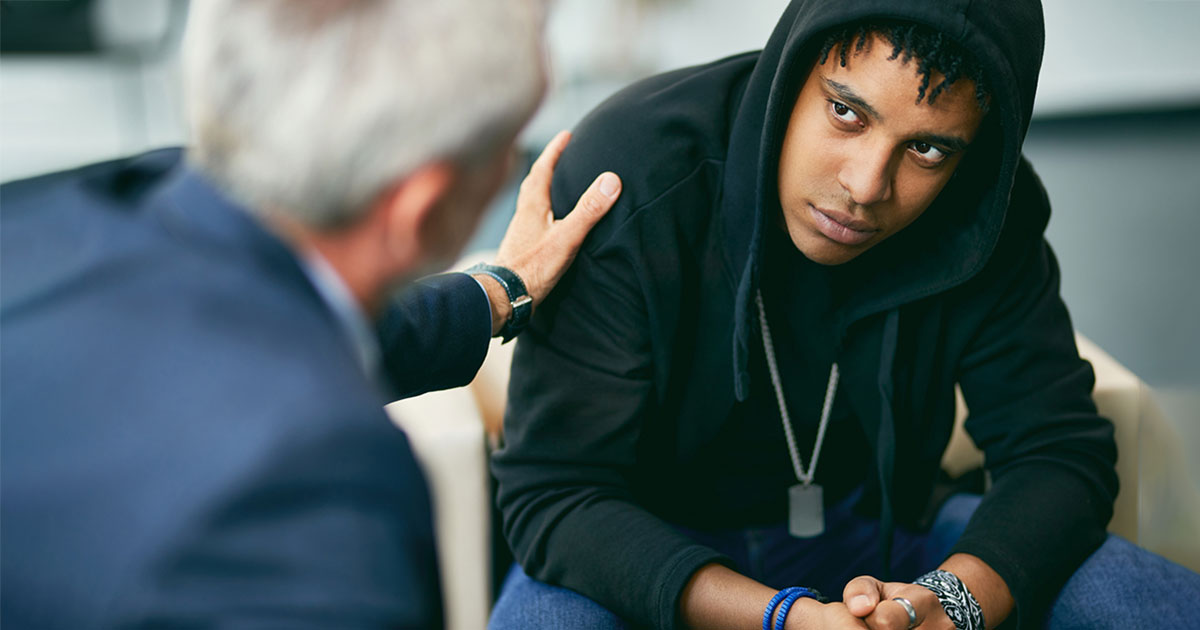
In the past few years, there has been a reckoning nationwide as to the history of racial injustice and its continued effects on people of color. The murder of George Floyd and countless other Black people by police has reinvigorated a national discussion of racial injustice in the U.S.
One only needs to observe one day in a Wisconsin courtroom to see racial disparity in stark reality. As a youth defense attorney in northeast Wisconsin for the past nine years, I have represented a large number of youth of color, disproportionate to the population at large in the state and the region.
Research supports this experience: children of color throughout the country and specifically in Wisconsin experience contacts with police, juvenile intake, and juvenile courts at a higher rate than their white peers.1 It is in the interest of all justice stakeholders to recognize this disproportionality and to take steps to make the juvenile justice system more just for
all children.
Wisconsin Justice and Racial Disparity
Wisconsin ranks at the top of the entire country in terms of racial disparity in several categories.
 Alaina Fahley, Marquette 2013, is a staff attorney with the Wisconsin State Public Defender in Appleton, where she focuses on youth and family defense.
Alaina Fahley, Marquette 2013, is a staff attorney with the Wisconsin State Public Defender in Appleton, where she focuses on youth and family defense.
In 2021,
The Sentencing Project found that Wisconsin imprisons adult Black residents at a higher rate than any other state in the country: One in every 36 Black Wisconsin adults is in prison.2 This disparity carries through to other areas, affecting youth directly before any involvement with the youth justice system, including education, income, and unemployment.
The school-to-prison pipeline is particularly prevalent in Wisconsin. The Wisconsin Department of Public Instruction recently confirmed that our children face the worst achievement gap in the country.3
Finally, even with the lens of the COVID-19 pandemic, which allowed the system to reconsider detaining and incarcerating youth, Black, indigenous, Asian American, and Latinx youth continued to be represented at disparate rates in the juvenile justice system in Wisconsin. While Black youth only constitute 11.2% of the Wisconsin youth population, the Wisconsin Department of Children and Families report that they make up almost one quarter of the youth justice referrals.4
In 2021, the Sentencing Project found that the disparity present in the adult justice system in Wisconsin also applies in the youth system: Wisconsin has the third highest racial disparity in the nation.5 This applies at all stages of the youth justice system: arrest, diversion, detention, and commitment. White children are more likely to not be arrested and to receive the benefit of diversion from the court system.6
Further, they are less likely to be ordered to be detained pre-adjudication and to be placed in juvenile corrections when adjudicated.7 In 2015, about 21% of Black youth and 9% of white youth were detained.8 Wisconsin had a detention rate 50% higher than the national average for Black youth (148 per 100,000), and detains Black youth 19 times more often than white youth.9
This disproportionality is not explained by actual rates of delinquency among children of different races. The data shows that Black, Latinx, and white children are engaged in delinquent behavior at similar rates.10
Therefore, there must be something else at play to explain the impact of race on the youth justice system.
Addressing Youth Justice Bias
How do youth justice system stakeholders address this painful reality in Wisconsin?
Increase awareness of the effects of implicit bias. The disparities in the youth justice system nationwide and in Wisconsin need not be the result of direct racial animus or explicit bias. No one currently living is responsible for slavery and the historical impact of this history on Black Americans. But history can impact decision making without any intent, and even with an intent to treat all people fairly.
Implicit bias is defined as "the attitudes or stereotypes that affect our understanding, actions, and decisions in an unconscious manner."11 Implicit bias can impact all stakeholders in the youth justice system, from intake workers and prosecutors to defense attorneys and judges. Research shows that implicit bias can cause stakeholders to "consciously or subconsciously associate Black youth with crime and dangerousness."12
Youth justice stakeholders ought to recognize their individual implicit bias and work to recognize this reality in their practice area. Even as a youth defense attorney, I have had to confront my own implicit biases as I represent children of color.
Understand the impact of racial trauma on children of color. A child of color who becomes entangled in the youth justice system in Wisconsin is likely to have grown up learning about the disproportionate police presence in their community. Children can experience the disproportionate involvement of police in the Black community as physical and psychological trauma.
Our state and national community has observed increased tensions between Black youth and the police. Black youth report an increased level of anxiety and trauma associated with experiences with police.13 Pervasive police presence in Black communities can result in trauma and stress even when children are observing others' interactions with police and not experiencing it themselves.14 This can be exacerbated by the widespread media coverage of police interactions with Black individuals.15
The youth defense system in Wisconsin ought to view the children of color that encounter the system as children who have collectively experienced trauma that can impact their behavior and experiences from arrest to disposition.
Understand the intersection of race, adolescence, and normal behavior. Children of color are more likely to be treated as older and less innocent when interacting with the youth justice system. This lens can influence youth justice system stakeholders in their interpretation of a child's behavior and whether it rises to the level of a crime. A white child who is being loud and running around with their friends on a basketball court may be treated very differently than a Black child in that same position.
A 2017 study by the Georgetown Law Center on Poverty and Inequality found that adults of all races view "Black girls as less innocent and more adult-like than their white peers."16 A similar study in 2016 found that "people are more likely to perceive innocuous objects as guns when associating the object with a Black child than with a white child."17
To address these concerns, stakeholders ought to question whether the same behavior alleged in a delinquency court would be viewed the same for children of color as their white peers.
Conclusion: Wisconsin Needs to Treat All Its Children as Children
Addressing the reality of racial disparity in Wisconsin's youth justice system is not a simple or easy task, but it is in each system participant's interest to work toward a more just and equitable system for all of Wisconsin's children.
This is a task that will require the work of all stakeholders, and the first step is to recognize the problem. The future of our state depends on it.
This article was originally published on the State Bar of Wisconsin's
Children & the Law Section Blog. Visit the State Bar
sections or the
Children & the Law Section webpages to learn more about the benefits of section membership.
Endnotes
1 Joshua Rovner, The Sentencing Project Report:
Racial Disparities in Youth Commitments and Arrests, April 1, 2016; Kids Forward,
The Complex Maze of the Juvenile Justice System in Wisconsin and Its Impact on Youth of Color, August 2018.
2 Ashley Nellis, Ph.D., The Sentencing Project Report:
The Color of Justice: Racial and Ethnic Disparity in State Prisons, Oct. 13, 2021.
3 Wisconsin Department of Public Instruction,
Racial disparities and our collective will, April 19, 2022, citing
The Nation's Report Card, Wisconsin Student Groups and Gaps.
4 Wisconsin Department of Children and Families,
Wisconsin Youth Justice Referrals and Intakes Annual Report for Calendar Year 2019, January 2021.
5 Joshua Rovner,
Racial Disparities in Youth Incarceration Persist, The Sentencing Project, February 2021, p. 7.
6 Wisconsin Department of Children and Families,
Wisconsin Youth Justice Referrals.
7 Rovner,
Racial Disparities in Youth Incarceration Persist, p. 4.
8 Wisconsin Office of Children's Mental Health,
Fact Sheet: Youth Justice, 2017 Annual Report.
9 Id.
10 U.S. Dept. of Health and Human Services Centers for Disease Control and Prevention,
Youth Risk Behavior Surveillance – United States, 2015,
Morbidity and Mortality Weekly Report, Surveillance Summaries, Vol. 65, No. 6 (2016).
11 Cheryl Staats,
et al.,
Implicit Bias,
State of the Science: Implicit Bias Review2016, Ohio State University Kirwan Institute for the Study of Race and Ethnicity, 2016.
12 Kristin N. Henning, "Criminalizing Normal Adolescent Behavior in Communities of Color: The Role of Prosecutors in Juvenile Justice Reform,"
Cornell Law Review 98 (2013): 420.
13 Amanda Geller,
et al., "Aggressive Policing and the Mental Health of Young Urban Men,"
Am. J. Pub. Health, 2014.
14 Amber J. Landers,
et al., "Police Contacts and Stress Among African American College Students,"
Am. J. Orthopsychiatry, 2011.
15 Brendesha M. Tynes,
et al., "Race-Related Traumatic Events Online and Mental Health Among Adolescents of Color,"
J. Adolescent Health, 2019.
16 Jamilia Blake, Rebecca Epstein & Thalia Gonzalez, "Girlhood Interrupted: The Erasure of Black Girls' Childhood," Georgetown Law Center on Poverty and Inequality (2017).
17 Andrew R. Todd, Kelsey C. Thiem, and Rebecca Neal, "Does Seeing Faces of Young Black Boys Facilitate the Identification of Threatening Stimuli?"
Psychological Sci., 2016.
